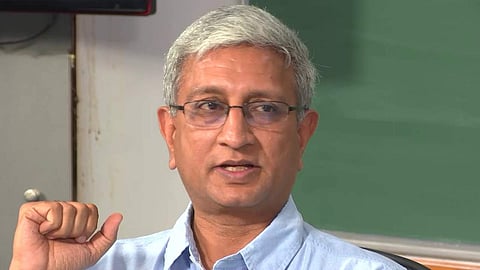

K N Satyanarayana, the Director of IIT Tirupati, has a dynamic personality that his students and faculty admire. He is also an expert administrator, civil engineering visionary and dons more hats than a regular man could ever juggle. As he bid adieu to his first batch he sat down for a short chat on his journey with IIT Tirupati so far and what he thinks about the research scenario in India. Excerpts from the conversation:
Out of all the third-gen IITs, Tirupati was among those who grew the fastest. How was it possible to set up an IIT so fast?
We had the full support from the MHRD and the State government too has been highly supportive. The land got allotted with hardly any trouble. The major problem in many of these campuses is that there are local issues even after the state gives you the land. I have had experience working on developing campuses and that helped. I had a team who were highly experienced and talented.
What would you say is the significance of having an IIT in Tirupati even though it is only about 100 km from IIT Madras?
When the Andhra Pradesh government thought of establishing an IIT here they were planning to transform Tirupati into a knowledge hub. They wanted to diversify and spread out the institution across the state and not concentrate them in a major city like Hyderabad in the composite Andhra Pradesh. Once the bifurcation took place, almost every central institution has been established in the new Andhra Pradesh. I think the government is looking to make AP an education hub. That is one of the reasons why they had considered to put up both IIT and ISER in Tirupati. But not only that, Vishakhapatnam has an IIM, Tadepalligudem has an NIT, IIIT in Kurnool, School of Planning and Architecture in Vijayawada and the list goes on. They have decided to distribute the institutes among the Tier-2 cities and towns. Tirupati will, however, be a major player in this transformation.
We see a long list of Telugu students across IITs. How is the demography here?
Around 55 per cent of your students is Telugu. But then again 45 per cent of the students in IIT Madras is Telugu as well. So, I wouldn't say that the numbers are very different even though we are based in one of the Telugu-speaking states. The number of Telugu students applying and aspiring for IIT is much more than in any other part of India. That is a major reason where they are there in every IIT including this one.
You just had your first placement this year. How would you say the trend of jobs vs higher education has evolved over the years? Where do we stand now?
More and more IIT graduates are now opting for jobs once they graduate. Merely, 10 per cent want to directly go for higher education abroad now. When I graduated from IIT Madras in 1984 almost 70 per cent of the students went abroad for higher studies abroad immediately and eventually, 80 per cent of the batch went to different countries for their higher education. But now it's only 10 per cent. There are more students opting for higher studies in India but as a percentage that has come down as well. As an absolute number it has obviously gone up as the number of students have increased exponentially — when I graduated there were 2,500 students on the whole campus, now it's over 10,000. Job opportunity also depends on the department or branch as well. As a new institution who went for placements for the first time, I think we did reasonably well. Companies have shown interest to come back the next year as well.
The draft NEP had proposed setting up a central foundation to distribute and regulate research funds and grants. Do you think it is a step forward to propagate research in the country?
The amount India spends on education is still at a much lower level when compared to other countries. We get funding from various departments like DST, MHRD and many other ministries. The National Research Foundation was set up, I think, to help consolidate these and bring all the channels of funding under one roof so that it can be dispensed and used more effectively. NRF is also looking at establishing world-class institutes.
